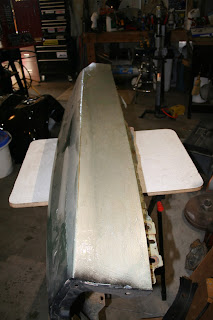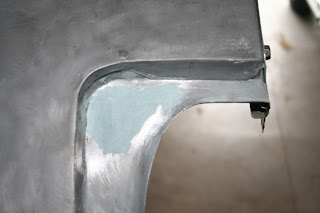I've decided that stripping paint off a project car is like opening a Christmas Present from your Grandmother. You really want to open it and see what it is, but you know it's going to be an ugly sweater. Sure enough. I started stripping paint and found about 1/2" of Bondo on the passenger side fender. It had to have been there for 20 or so years. It was surprising that it held that long since it was so thick, but it was pretty solid.
So, off comes the paint
And here's what I found in my "Christmas Present from Grandma"
Who drives that far through road tar?
Bumper rub hole.
The worst part was that the dent was right on the body like that goes up the side of the LeMans. It was obvious they didn't remove the fender to fix it at the body shop. They did the best they could hammering it out and then filled it in.
I went to the fiberglass upper grill piece and made a template to bolt onto the fender so I would know where to rough in the shape and the body line.
It worked pretty good. If you look closely in this photo you can see the work I had to put into it. Because the body shop was beating on it while it was on the car, the angle forced them to get the body line about a half of an inch too low. In the picture you can see a dark line where the peak used to be before I worked it up to the crown mark on my template. Of course, it's still going to need body filler, but probably about 3/8" less than it had.
Then came the rust removal and patching.
This hole seemed to have been rubbed in the fender by the bumper. So I ground it out and gave it a good soaking with phosphoric acid to convert the rust I couldn't get.
Then I cut a patch.
Welded it in.
Then covered it with a waterproof short strand fiberglass enhanced body filler. It will keep moisture or even humidity from getting through possible pinholes in the weld, which other body filler would soak up and turn to rust. It's just rough sanded for now. It will get worked more when I do the finish work.
The rusted out spot.
There was a rusted out hole behind the lower chrome (which I will NOT be putting back on). There were also a couple of holes one from the chrome and the other from an emblem...I think.
I removed the rust with a cutting wheel. I later wished I had cut out a rectangle instead of a triangle. I ended up burning through the two points and it took quite a bit of work to fill them in and make it look good.
I scraped, brushed and chiseled away as much rust as I could see and then I soaked the brace plate with phosphoric acid and converted as much rust as possible. Then followed up with a rust converting paint. I still plan to work the back side of the fender, catalyze it with acid and paint it
with POR-15. I love that stuff
I then fit a patch.
Welded it in place and welded the two bracket holes closed.
Hit the welds with a grinder.
Prepped it with a 36 grit and a pre-paint cleaner.
Then covered it with the short strand fiberglass enhanced filler to keep the humidity on the outside.
I finished the patch off with filler, covered the fender in glazing putty, then finished the sanding.
Lastly, a coat of epoxy primer. In the picture you can see how the filler absorbed the epoxy and sealed.




























































